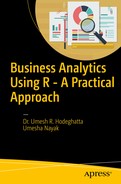Book Description
Learn the fundamental aspects of the business statistics, data mining, and machine learning techniques required to understand the huge amount of data generated by your organization. This book explains practical business analytics through examples, covers the steps involved in using it correctly, and shows you the context in which a particular technique does not make sense. Further, Practical Business Analytics using R helps you understand specific issues faced by organizations and how the solutions to these issues can be facilitated by business analytics.
This book will discuss and explore the following through examples and case studies:
- An introduction to R: data management and R functions
- The architecture, framework, and life cycle of a business analytics project
- Descriptive analytics using R: descriptive statistics and data cleaning
- Data mining: classification, association rules, and clustering
Predictive analytics: simple regression, multiple regression, and logistic regression
This book includes case studies on important business analytic techniques, such as classification, association, clustering, and regression. The R language is the statistical tool used to demonstrate the concepts throughout the book.
What You Will Learn
• Write R programs to handle data
• Build analytical models and draw useful inferences from them
• Discover the basic concepts of data mining and machine learning
• Carry out predictive modeling
• Define a business issue as an analytical problem
Who This Book Is For
Beginners who want to understand and learn the fundamentals of analytics using R. Students, managers, executives, strategy and planning professionals, software professionals, and BI/DW professionals.
